Themed collection New Talent: Europe

Front cover
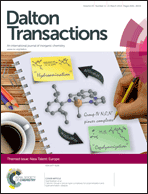
Inside front cover
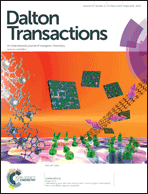
Back cover
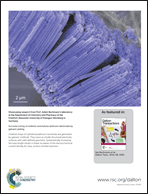
New Talent: Europe
Welcome to this themed issue of Dalton Transactions entitled “New Talent: Europe.”

Dalton Trans., 2014,43, 4196-4196
https://doi.org/10.1039/C4DT90016B
Interweaving spins with their environment: novel inorganic nanohybrids with controllable magnetic properties
We discuss the developments in the synthesis and characterization of magnetic nanohybrids made of molecular magnets and nanostructured materials.

Dalton Trans., 2014,43, 4220-4232
https://doi.org/10.1039/C3DT52650J
A golden future in medicinal inorganic chemistry: the promise of anticancer gold organometallic compounds
This review provides an overview of the recent results concerning anticancer organometallic gold compounds and related mechanistic insights.
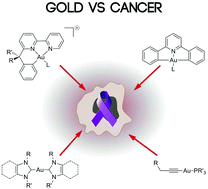
Dalton Trans., 2014,43, 4209-4219
https://doi.org/10.1039/C3DT52524D
State of the art of Lewis acid-containing zeolites: lessons from fine chemistry to new biomass transformation processes
New transition metal-containing zeolites presenting Lewis acid character show unique catalytic applications in fine chemistry processes and novel biomass-transformation.
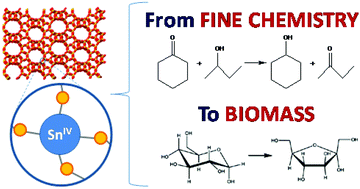
Dalton Trans., 2014,43, 4197-4208
https://doi.org/10.1039/C3DT52293H
Platinoid complexes to target monomeric disordered peptides: a forthcoming solution against amyloid diseases?
We conjecture that the combination of a platinoid complex and an IDP (intrinsically disordered peptides) recognition unit can be one solution for targeting efficiently (monomeric) IDP and inhibiting their aggregation into deleterious amyloids.
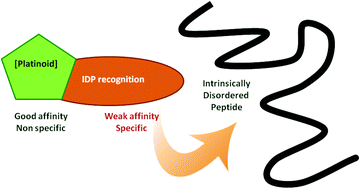
Dalton Trans., 2014,43, 4233-4237
https://doi.org/10.1039/C3DT52954A
Mechanism of phenol oxidation by heterodinuclear Ni Cu bis(μ-oxo) complexes involving nucleophilic oxo groups
Both PCET and HAT mechanisms can be feasible for the oxidation of phenols by heterodinuclear CuIII(μ-O)2NIII complexes.
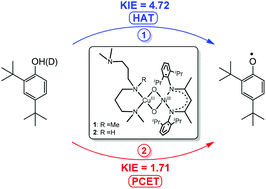
Dalton Trans., 2014,43, 4264-4267
https://doi.org/10.1039/C3DT52644E
A tetradentate metalloligand: synthesis and coordination behaviour of a 2-pyridyl-substituted cyclobutadiene iron complex
A novel cyclobutadiene iron complex with four 2-pyridyl-substitutents acts as a bis(bidentate) chelate ligand toward Zn2+ cations.
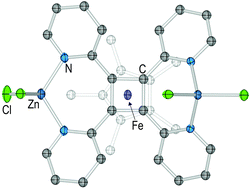
Dalton Trans., 2014,43, 4247-4250
https://doi.org/10.1039/C3DT52699B
A novel 99mTc labelling strategy for the development of silica based particles for medical applications
The reaction of high-valent fac-{99mTcO3}+ complexes with alkenes ((3 + 2)-cycloaddition) has been used to develop a novel stereoselective labelling procedure for silica based particles.
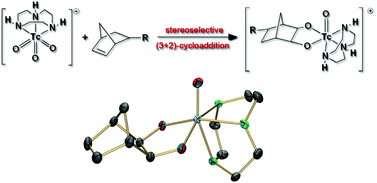
Dalton Trans., 2014,43, 4260-4263
https://doi.org/10.1039/C3DT53019A
Reactivity of three-coordinate iron–NHC complexes towards phenylselenol and lithium phenylselenide
The three-coordinate iron(II) NHC complexes [(IPr)Fe(N′′)2] (1) and [(ItBu)Fe(N′′)2] (3) (N′′ = N(SiMe3)2) react with PhSeH or LiSePh to give the iron(II) selenolates [(IPr)Fe(N′′)(SePh)] (6) and [ItBu(H)][(aItBu)Fe(SePh)3], [ItBu(H)][7], with complex 7 containing an abnormal NHC ligand.
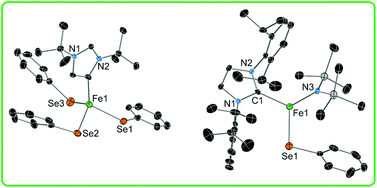
Dalton Trans., 2014,43, 4251-4254
https://doi.org/10.1039/C3DT53203H
Silver nanoparticles supported on alumina–a highly efficient and selective nanocatalyst for imine reduction
Ag nanoparticles were successfully stabilized on alumina. The catalyst showed high selectivity in the reduction of imines. It was easily recovered and reused without any loss in its activity. Furthermore, it could also catalyze the tandem synthesis of secondary amines from primary amines.
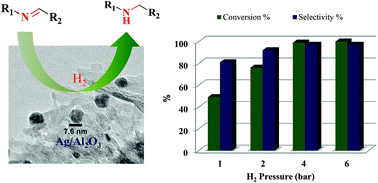
Dalton Trans., 2014,43, 4255-4259
https://doi.org/10.1039/C3DT52499J
Copolymerization of cyclohexene oxide with CO2 catalyzed by tridentate N-heterocyclic carbene titanium(IV) complexes
A new class of complexes based on titanium(IV) bearing a bisanionic mer-tridentate N-heterocyclic carbene ligand were investigated for the copolymerization of cyclohexene oxide with CO2. Upon addition of [PPN]X′ salts, all complexes were found to be active and highly selective toward the formation of PCHC.

Dalton Trans., 2014,43, 4242-4246
https://doi.org/10.1039/C3DT52804A
The first enantiopure lanthanoid cryptate
The first enantiomerically pure 2,2′-bipyridine-based cryptand and the corresponding luminescent ytterbium cryptate are reported.
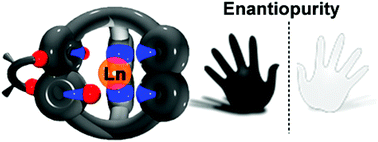
Dalton Trans., 2014,43, 4238-4241
https://doi.org/10.1039/C3DT51289D
The role of carboxylato ligand dissociation in the oxidation of chrysin with H2O2 catalysed by [Mn2III,IV(μ-CH3COO)(μ-O)2(Me4dtne)](PF6)2
The loss of the acetato ligand is shown to be key to the activity of this manganese catalyst at pH 11 in bleaching of chrysin.
2](/en/Image/Get?imageInfo.ImageType=GA&imageInfo.ImageIdentifier.ManuscriptID=C3DT53174K&imageInfo.ImageIdentifier.Year=2014)
Dalton Trans., 2014,43, 6322-6332
https://doi.org/10.1039/C3DT53174K
Narcissistic self-sorting vs. statistic ligand shuffling within a series of phenothiazine-based coordination cages
The self-assembly of heterogeneous or homogeneous cages from a mixture of ligands is a function of the ligand length and reaction kinetics.
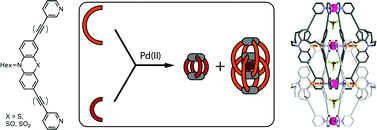
Dalton Trans., 2014,43, 4587-4592
https://doi.org/10.1039/C3DT53243G
[Ru(η5-C5H5)(η6-C10H8)]PF6 as a catalyst precursor for the one-pot direct C–H alkenylation of nitrogen heterocycles
The ruthenium naphthalene complex [Ru(η5-C5H5)(η6-C10H8)]+ is a catalyst precursor for the direct C–H alkenylation of pyridine and related nitrogen heterocycles by terminal alkynes.
![Graphical abstract: [Ru(η5-C5H5)(η6-C10H8)]PF6 as a catalyst precursor for the one-pot direct C–H alkenylation of nitrogen heterocycles](/en/Image/Get?imageInfo.ImageType=GA&imageInfo.ImageIdentifier.ManuscriptID=C3DT52984C&imageInfo.ImageIdentifier.Year=2014)
Dalton Trans., 2014,43, 4565-4572
https://doi.org/10.1039/C3DT52984C
Coordination and conformational isomers in mononuclear iron complexes with pertinence to the [FeFe] hydrogenase active site
6 Fe complexes of the type [Fe(X-bdt)(PR2NPh2)(CO)] were prepared and the possibility to tune their electronic properties by ligand modification was demonstrated. IR spectroscopic and computational studies suggest that the compounds exist as a mixture of isomers in solution.
![Graphical abstract: Coordination and conformational isomers in mononuclear iron complexes with pertinence to the [FeFe] hydrogenase active site](/en/Image/Get?imageInfo.ImageType=GA&imageInfo.ImageIdentifier.ManuscriptID=C3DT53268B&imageInfo.ImageIdentifier.Year=2014)
Dalton Trans., 2014,43, 4537-4549
https://doi.org/10.1039/C3DT53268B
DFT study on the reaction mechanism of the ring closing enyne metathesis (RCEYM) catalyzed by molybdenum alkylidene complexes
DFT calculations show that the RCEYM reaction catalyzed by Mo-based catalysts proceeds preferentially through an yne-then-ene mechanism and that the endo-/exo- selectivity mainly depends on sterics.
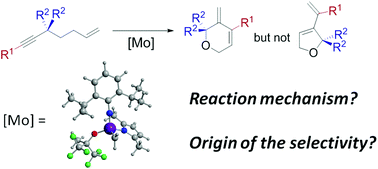
Dalton Trans., 2014,43, 4573-4586
https://doi.org/10.1039/C3DT53242A
Zinc and cobalt complexes based on tripodal ligands: synthesis, structure and reactivity toward lactide
Polymerization of lactide takes place in the presence of cobalt and zinc chloro complexes to yield polymers under solvent free conditions.
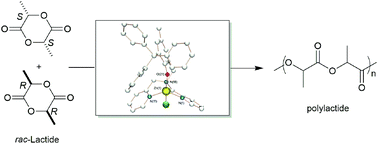
Dalton Trans., 2014,43, 4550-4564
https://doi.org/10.1039/C3DT52629A
Post-synthetic preparation of Sn-, Ti- and Zr-beta: a facile route to water tolerant, highly active Lewis acidic zeolites
Convenient synthesis of water-tolerant Lewis acidic beta zeolites opens new horizons for sustainable catalytic applications.
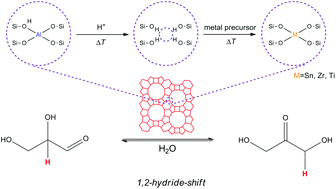
Dalton Trans., 2014,43, 4514-4519
https://doi.org/10.1039/C3DT52972J
Chiral phenoxyimino-amido aluminum complexes for the asymmetric cyanation of aldehydes
AlEt3 reacts with chiral phenoxyimine sulfonamides to afford mono-ethyl complexes that catalyze asymmetric addition of SiMe3CN to aldehydes with high yield and good to excellent enantioselectivity.

Dalton Trans., 2014,43, 4530-4536
https://doi.org/10.1039/C3DT53292E
[IrCl{N(CHCHPtBu2)2}]−: a versatile source of the IrI(PNP) pincer platform
The iridium(II) complex [IrCl{N(CHCHPtBu2)2}] is reduced by KC8 to give the anionic iridium(I) pincer complex [IrCl{N(CHCHPtBu2)2}]− which was isolated and fully characterized upon stabilization of the counter cation with crown ether as [K(15-cr-5)2][IrCl{N(CHCHPtBu2)2}].
![Graphical abstract: [IrCl{N(CHCHPtBu2)2}]−: a versatile source of the IrI(PNP) pincer platform](/en/Image/Get?imageInfo.ImageType=GA&imageInfo.ImageIdentifier.ManuscriptID=C3DT53304B&imageInfo.ImageIdentifier.Year=2014)
Dalton Trans., 2014,43, 4506-4513
https://doi.org/10.1039/C3DT53304B
Computational insights into carbon–carbon homocoupling reactions mediated by organolanthanide(III) complexes
Homocoupling of terminal alkynes into trienediyl complexes by samarocenes is controlled by the right combination of sterics of the ancillary ligands.

Dalton Trans., 2014,43, 4520-4529
https://doi.org/10.1039/C3DT52937A
Synthesis, structure and reactivity of Ni site models of [NiFeSe] hydrogenases
A series of structural models of the Ni centre in [NiFeSe] hydrogenases display reactivity relevant to the enzyme.
![Graphical abstract: Synthesis, structure and reactivity of Ni site models of [NiFeSe] hydrogenases](/en/Image/Get?imageInfo.ImageType=GA&imageInfo.ImageIdentifier.ManuscriptID=C3DT52967C&imageInfo.ImageIdentifier.Year=2014)
Dalton Trans., 2014,43, 4483-4493
https://doi.org/10.1039/C3DT52967C
Yellow-light sensitization of a ligand photosubstitution reaction in a ruthenium polypyridyl complex covalently bound to a rhodamine dye
A rhodamine dye was covalently attached to a ruthenium complex to enhance the rate of ligand photosubstitution under yellow light irradiation.
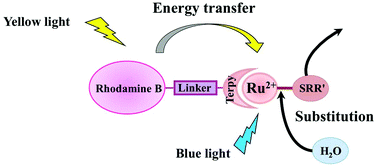
Dalton Trans., 2014,43, 4494-4505
https://doi.org/10.1039/C3DT52643G
Metal-assisted conversion of an N-ylide mesomeric betaine into its carbenic tautomer: generation of N-(fluoren-9-yl)imidazol-2-ylidene complexes
9-(Imidazolium-3-yl)fluorenide, an N-ylide mesomeric betaine, isomerises only upon complexation to afford the corresponding monoligated N-heterocyclic carbene complexes, via a fluorenyl-coordinated intermediate.
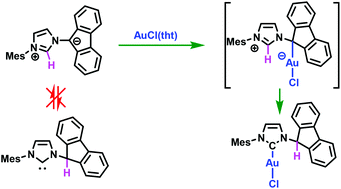
Dalton Trans., 2014,43, 4474-4482
https://doi.org/10.1039/C3DT53089B
Synthesis and catalytic alcohol oxidation and ketone transfer hydrogenation activity of donor-functionalized mesoionic triazolylidene ruthenium(II) complexes
Depending on the donor functionality, triazolylidene ruthenium complexes are catalytically highly active in either alcohol oxidation or ketone transfer hydrogenation.
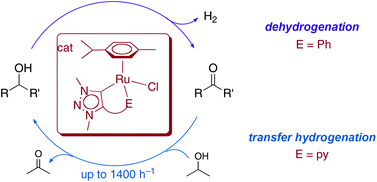
Dalton Trans., 2014,43, 4462-4473
https://doi.org/10.1039/C3DT53052C
Synthesis, characterization and reactivity of an imidazolin-2-iminato aluminium dihydride
We report on the synthesis, characterization and reactivity of a novel aluminium dihydride complex utilizing a bulky imidazolin-2-iminato ligand.
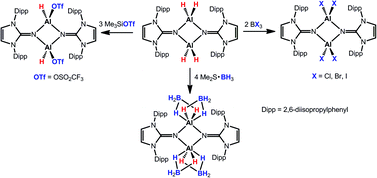
Dalton Trans., 2014,43, 4451-4461
https://doi.org/10.1039/C3DT52637B
The redox series [Ru(bpy)2(L)]n, n = +3, +2, +1, 0, with L = bipyridine, “click” derived pyridyl-triazole or bis-triazole: a combined structural, electrochemical, spectroelectrochemical and DFT investigation
Structural, spectroelectrochemical and theoretical results on complexes [Ru(bpy)2L]n+ are presented.
![Graphical abstract: The redox series [Ru(bpy)2(L)]n, n = +3, +2, +1, 0, with L = bipyridine, “click” derived pyridyl-triazole or bis-triazole: a combined structural, electrochemical, spectroelectrochemical and DFT investigation](/en/Image/Get?imageInfo.ImageType=GA&imageInfo.ImageIdentifier.ManuscriptID=C3DT52898G&imageInfo.ImageIdentifier.Year=2014)
Dalton Trans., 2014,43, 4437-4450
https://doi.org/10.1039/C3DT52898G
An EXAFS and HR-XANES study of the uranyl peroxides [UO2(η2-O2)(H2O)2]·nH2O (n = 0, 2) and uranyl (oxy)hydroxide [(UO2)4O(OH)6]·6H2O
EXAFS and high-resolution XANES spectroscopy has been used to explore the local coordination and electronic environment of three uranyl minerals relevant to storage of spent nuclear fuel.
![Graphical abstract: An EXAFS and HR-XANES study of the uranyl peroxides [UO2(η2-O2)(H2O)2]·nH2O (n = 0, 2) and uranyl (oxy)hydroxide [(UO2)4O(OH)6]·6H2O](/en/Image/Get?imageInfo.ImageType=GA&imageInfo.ImageIdentifier.ManuscriptID=C3DT52437J&imageInfo.ImageIdentifier.Year=2014)
Dalton Trans., 2014,43, 4400-4407
https://doi.org/10.1039/C3DT52437J
Luminescent alkynyl-gold(I) coumarin derivatives and their biological activity
The synthesis and characterization of three propynyloxycoumarins are reported in this work together with the formation of three different series of gold(I) organometallic complexes.
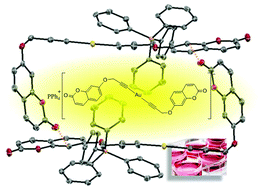
Dalton Trans., 2014,43, 4426-4436
https://doi.org/10.1039/C3DT52594E
Nitrite complexes of the rare earth elements
The coordination chemistry of the nitrite anion has been investigated with rare earth elements, and the resulting complexes were structurally characterized. Among them, the first homoleptic examples of nitrite complexes of samarium, ytterbium and yttrium are described. The coordination behavior of the nitrite ion is directly controlled by the ionic radius of the metal cation.
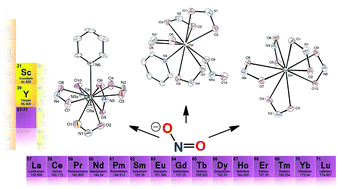
Dalton Trans., 2014,43, 4415-4425
https://doi.org/10.1039/C3DT52703D
A family of cationic oxime-based hexametallic manganese(III) single-molecule magnets
Three novel cationic oxime-based hexametallic manganese(III) single-molecule magnets have been magnetostructurally studied. Our results suggest that these cationic [Mn6]2+ species could be used as suitable building blocks for preparing new materials with different functionalities.
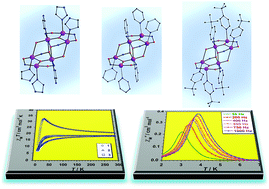
Dalton Trans., 2014,43, 4408-4414
https://doi.org/10.1039/C3DT52640B
Structural rearrangements induced by acid–base reactions in metal carbonyl clusters: the case of [H3−nCo15Pd9C3(CO)38]n− (n = 0–3)
An unprecedented inversion of the Pd9 core from octahedral to trigonal prismatic has been discovered upon deprotonation of bimetallic Co–Pd tri-carbide poly-hydride carbonyl clusters.
![Graphical abstract: Structural rearrangements induced by acid–base reactions in metal carbonyl clusters: the case of [H3−nCo15Pd9C3(CO)38]n− (n = 0–3)](/en/Image/Get?imageInfo.ImageType=GA&imageInfo.ImageIdentifier.ManuscriptID=C3DT52527A&imageInfo.ImageIdentifier.Year=2014)
Dalton Trans., 2014,43, 4388-4399
https://doi.org/10.1039/C3DT52527A
Water-oxidation catalysis by synthetic manganese oxides – systematic variations of the calcium birnessite theme
Optimised preparation parameters for calcium-birnessite water-oxidation catalysts could be identified by systematic variations of a versatile synthesis protocol.
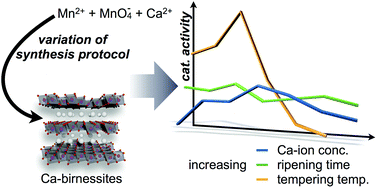
Dalton Trans., 2014,43, 4370-4379
https://doi.org/10.1039/C3DT52604F
Alkali metal derivatives of an ortho-phenylene diamine
Deprotonation of a diamine with alkali metal alkyls affords diamide dianion or radical anion derivatives depending on the alkali metal.
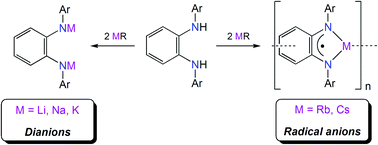
Dalton Trans., 2014,43, 4351-4360
https://doi.org/10.1039/C3DT52632A
Bis(triphenyl-λ5-phosphanylidene)ammonium fluoride: a reactive fluoride source to access the hypervalent silicates [MenSiF5−n]− (n = 0–3)
The synthesis, full characterization and selected reactions of bis(triphenyl-λ5-phosphanylidene)-ammonium fluoride ((Ph3PNPPh3)F, abbreviated as (PNP)F), are described.
![Graphical abstract: Bis(triphenyl-λ5-phosphanylidene)ammonium fluoride: a reactive fluoride source to access the hypervalent silicates [MenSiF5−n]− (n = 0–3)](/en/Image/Get?imageInfo.ImageType=GA&imageInfo.ImageIdentifier.ManuscriptID=C3DT52617H&imageInfo.ImageIdentifier.Year=2014)
Dalton Trans., 2014,43, 4326-4334
https://doi.org/10.1039/C3DT52617H
Probing the metallating ability of a polybasic sodium alkylmagnesiate supported by a bulky bis(amido) ligand: deprotomagnesiation reactions of nitrogen-based aromatic substrates
The ability of sodium magnesiate 1 to promote direct Mg–H exchange processes has been demonstrated by studying its reactivity towards N-methyl-benzimidazole and pyrrole.
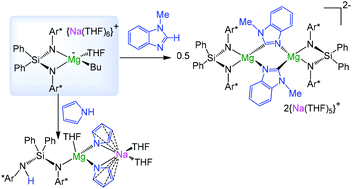
Dalton Trans., 2014,43, 4361-4369
https://doi.org/10.1039/C3DT52639A
A metallacyclic alkyl-amido carbene complex (MCAAC)
The preparation and structure of the first metallacyclic alkyl-amido carbene complex is reported, including NMR spectroscopic, computational and cyclic voltammetry studies of the bimetallic RuII–IrIII complex (see figure).
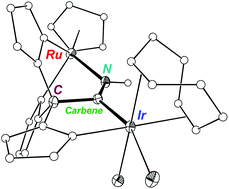
Dalton Trans., 2014,43, 4313-4319
https://doi.org/10.1039/C3DT52591K
Accurate tuning of ordered nanotubular platinum electrodes by galvanic plating
Platinum nanotubes are electrodeposited in ordered arrays and further utilized as a structured electrode surface of accurately tunable geometry.
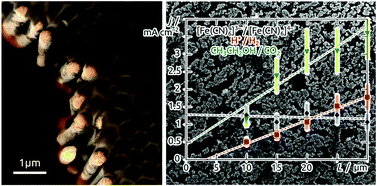
Dalton Trans., 2014,43, 4345-4350
https://doi.org/10.1039/C3DT52608A
N-aromatic heterocycle adducts of bulky [1,2,4-(Me3C)3C5H2]2Sm: synthesis, structure and solution analysis
The reactions of pyridine, Me-pyridine, 4-tert-butyl-pyridine, isoquinoline or quinoline, (L), with bulky samarocene do not lead to any electron transfer but to Sm(II) – neutral ligand coordination adducts in which the ligand L readily exchanges in solution.
![Graphical abstract: N-aromatic heterocycle adducts of bulky [1,2,4-(Me3C)3C5H2]2Sm: synthesis, structure and solution analysis](/en/Image/Get?imageInfo.ImageType=GA&imageInfo.ImageIdentifier.ManuscriptID=C3DT52641K&imageInfo.ImageIdentifier.Year=2014)
Dalton Trans., 2014,43, 4380-4387
https://doi.org/10.1039/C3DT52641K
Iron(II) complexes of ditopic carbanionic carbenes
The synthesis of the N-heterocyclic carbene complexes [Fe(IPr)(mes)2] (1) and [Fe(6-Xyl)(mes)2] (2) is reported. Chemical reduction of 1 using KC8 affords an anionic trigonal planar complex containing two ditopic carbanionic carbene ligands [{:C[N(2,6-iPr2C6H3)]2(CH)C}2Fe(mes)]− (3).
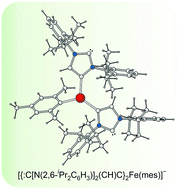
Dalton Trans., 2014,43, 4335-4344
https://doi.org/10.1039/C3DT52638K
On the structure and ambiphilicity of a sulfonyl substituted α-chloro lithium base
Electronic stabilization allows the isolation and characterization of a room temperature stable Li/Cl carbenoid and considerably influences its ambiphilic character.
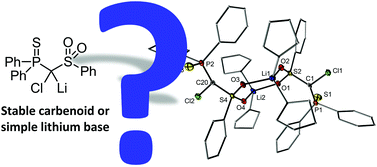
Dalton Trans., 2014,43, 4320-4325
https://doi.org/10.1039/C3DT52800F
Engineering microstructure and redox properties in the mixed conductor Ce0.9Pr0.1O2−δ + Co 2 mol%
The systematic study of Ce0.9Pr0.1O2−δ + Co 2 mol% sintering conditions allowed the microstructure and mixed ionic–electronic transport to be tailored.
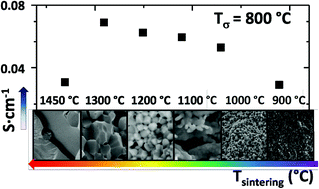
Dalton Trans., 2014,43, 4305-4312
https://doi.org/10.1039/C3DT52167B
Tuning ligand electronics and peripheral substitution on cobalt salen complexes: structure and polymerisation activity
A series of cobalt salen complexes, where salen represents an N2O2 bis-Schiff-base bis-phenolate framework, are prepared, characterised and investigated for reversible-termination organometallic mediated radical polymerisation (RT-OMRP).
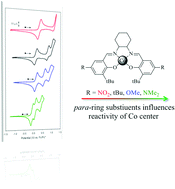
Dalton Trans., 2014,43, 4295-4304
https://doi.org/10.1039/C3DT51846A
Towards cancer cell-specific phototoxic organometallic rhenium(I) complexes
The use of Re(I) organometallic complexes and bioconjugates thereof as photosensitizers for photodynamic therapy purposes is presented.
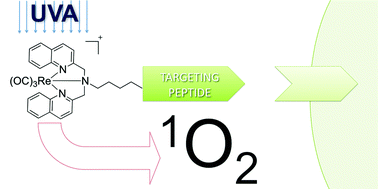
Dalton Trans., 2014,43, 4287-4294
https://doi.org/10.1039/C3DT51817E
Cationic Group-IV pincer-type complexes for polymerization and hydroamination catalysis
Intramolecular hydroamination reactions as well as ethylene–1-octene high-temperature copolymerizations are efficiently promoted by unsymmetrical cationic {N,C,N′} Group-IV pincer complexes.

Dalton Trans., 2013,42, 16056-16065
https://doi.org/10.1039/C3DT51620B
Stable divalent germanium, tin and lead amino(ether)-phenolate monomeric complexes: structural features, inclusion heterobimetallic complexes, and ROP catalysis
Germylenes, stannylenes and plumbylenes bearing amino(ether)-phenolate ligands, including some heterobimetallic complexes, catalyse the ROP of lactide.
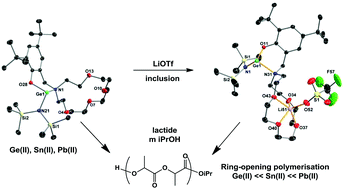
Dalton Trans., 2014,43, 4268-4286
https://doi.org/10.1039/C3DT51681D
About this collection
This themed issue, guest edited by Dr Marc Walter and Professor Matthias Tamm, highlights some of the leading research being carried out by the European inorganic and organometallic chemistry community.